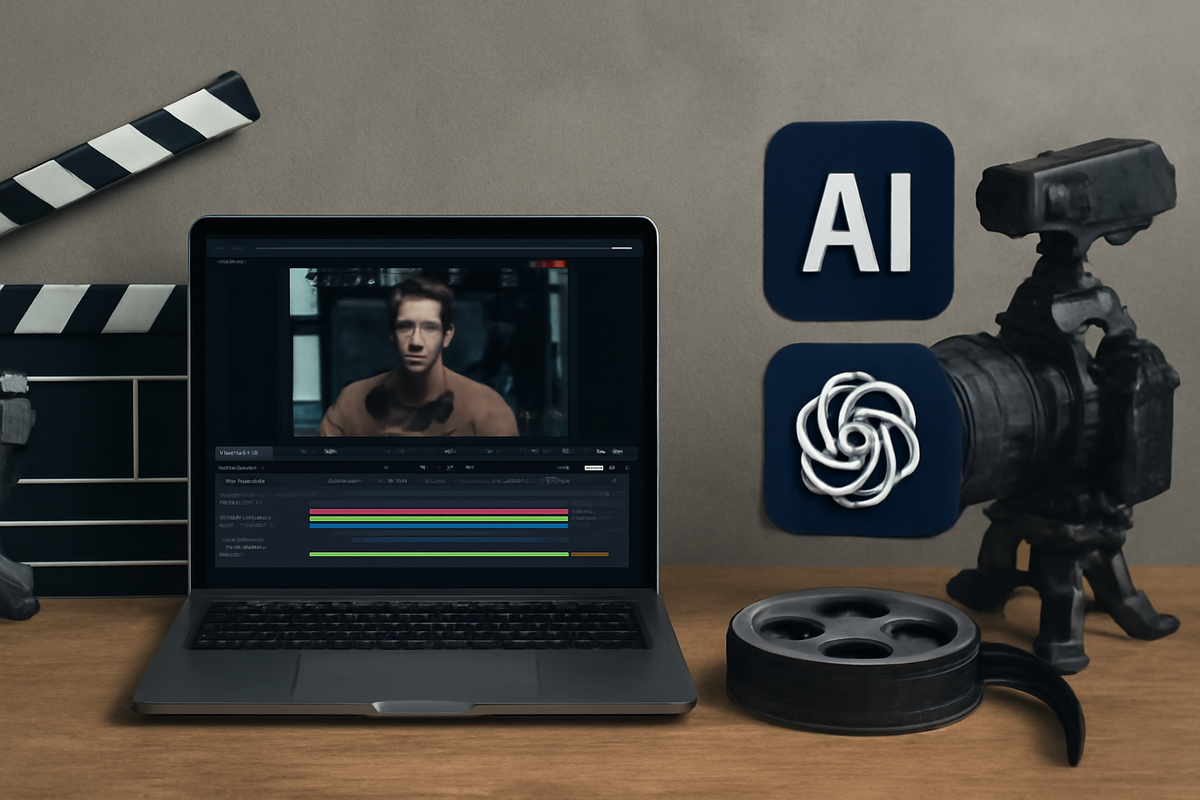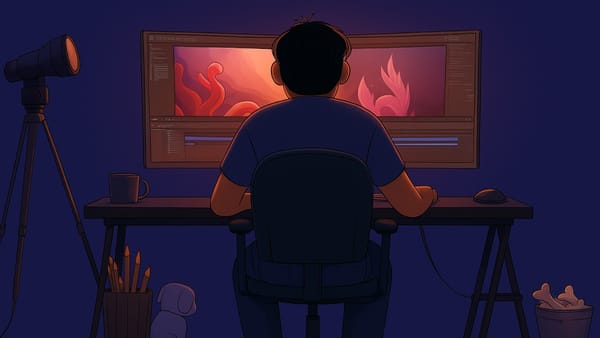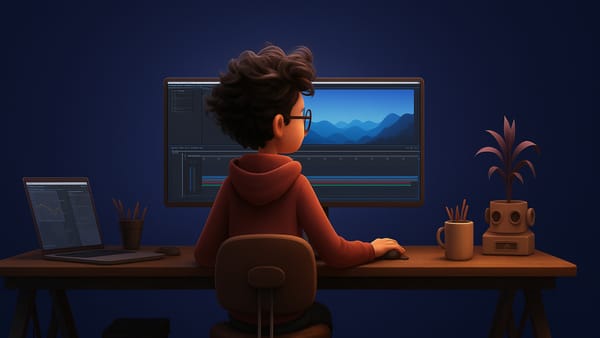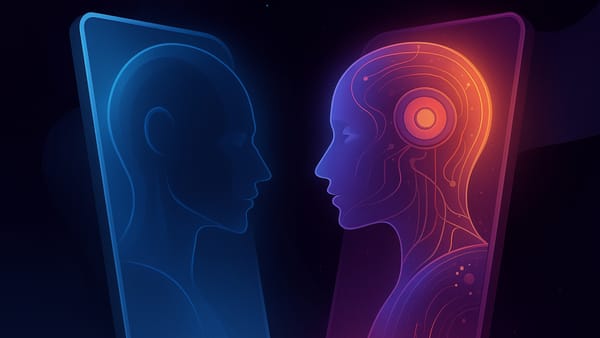Top AI Tools for Film Production in 2025
Discover the best AI tools for film production in 2025, from video automation to creative effects, optimizing workflows, and enhancing creative control.

Recent studies indicate that 75% of film studios utilize advanced AI tools in their production processes. Advanced AI tools, such as Frameo, Boords, and RunwayML, are transforming film production.
These platforms automate tasks such as video editing, color grading, and scene generation. By integrating machine learning, filmmakers can achieve greater efficiency and precision.
In this blog, we explore the top AI tools for film production in 2025 and their impact on modern filmmaking.
10 Best AI Tools for Film Production in 2025
The rise of AI tools for film production in 2025 is enhancing the precision of production workflows, from automated video editing to AI-driven visual effects. By using machine learning and advanced algorithms, these tools enable filmmakers to achieve higher levels of consistency and creativity throughout the production process.
Let’s explore the best AI tools for film production in 2025:
1. Frameo
Snippet of the Frameo website
Frameo utilizes AI automation to streamline the creation of vertical videos, while also optimizing content for social media platforms like Facebook, Instagram, and TikTok. Moreover, it also allows creators to generate professional-grade videos from simple text prompts, making it one of the top AI tools for film production in 2025.
Key Features:
- Text-to-video conversion: Frameo enables you to convert written prompts into dynamic videos, eliminating the need for complex video editing software.
- Image annotation: The platform transforms static images into animated visual content for an engaging storytelling experience.
- Storyboarding: It enables users to streamline their video structure and organize content for an enhanced visual appeal.
- Dubbing and voiceover capabilities: AI-enabled voice generation offers realistic dubbing and voiceover options, making them ideal for international content.
Pros and Cons:
Real-world use case:
Digital marketers and content creators use Frameo to rapidly produce their video content for social media platforms, including YouTube Shorts, Instagram Reels, and more. With advanced AI capabilities, Frameo users can create compelling content without hiring a production team.
Pricing:
- Free Plan: 200 credits, 1 video (with watermark)
- Explorer Plan ($25/month): 2500 credits (12 video slides or 4 animated videos)
- Creator Plan ($75/month): 9000 credits (45 video slides or 15 animated videos)
- Wizard Plan ($200/month): 25000 credits (125 video slides or 42 animated videos)
Frameo's pricing caters to both solo creators and large enterprises, providing scalable options to meet diverse video production needs.
2. Boords
Snippet of the Boords Website
Boards is a storyboarding tool that is prominent for simplifying video design during the pre-production process, making it one of the top AI tools for film production in 2025. With its user-friendly AI features, filmmakers can convert scripts into detailed sequences, facilitating smooth communication among team members and streamlining the film planning process.
Key features:
- Drag-and-drop interface: You can easily place and arrange scenes and shots with its drag-and-drop editor for engaging storyboard creation.
- Real-time collaboration: The platform allows cross-cultural teams to work on a production process simultaneously, providing immediate feedback and efficient pre-production processes.
- Integrated shot lists: Boords allows for direct integration of shot lists within the storyboard, ensuring character guidelines for consistent appearances.
Pros and Cons:
Real-world use case:
Boords can be used for detailed scene sequences for animated series, making it feasible for animators and directors to align their vision before production processes.
Pricing:
- Lite: $9/ 9/month, single user, up to five storyboards, with 50 AI image credits and unlimited exports.
- Standard: $44/month, allowing three team members to work together with 200 AI image credits, guest commenting, versioning, and more.
- Workflow: $89/month, with access to unlimited team members, along with customizable templates, project sharing links, and more.
Boords is best for 2D-focused filmmakers and early-stage planning, and is suitable for small to medium-sized projects.
3. Midjourney
Snippet of the Midjourney website
Midjourney specializes in generating high-quality imaginative visuals from textual prompts, which is ideal for filmmakers and creative professionals. It transforms descriptions into stunning visual concepts, along with offering possibilities for concept art, environment design, and more.
Key Feature:
- High-resolution imagery: Midjourney produces visuals with high resolution and offers vast flexibility in styles, including cyberpunk, noir, pastel, and more.
- Text-to-image generation: Midjourney takes written descriptions and generates highly detailed, stylistic images depending on the descriptive prompts.
- Flexible art direction: Users can guide Midjourney with specific instructions to adjust their tone, color palettes, and overall composition of the images to fit their desired aesthetics.
Pros and Cons:
Real-world use case:
Film directors can use Midjourney to create concept art for the settings of fantasy films, ensuring an appropriate visual tone, before contacting a design team. The AI-generated visuals can serve as a reference point for set designers to align the creative vision at the early stages.
Pricing:
- Basic :Plan: $10/month, the plan provides you with 3.3 fast hours per month, which translates to approximately 200 generations.
- Standard Plan: $30/month, the plan includes 154 fast hours, equivalent to approximately 1,000 generations.
- Pro Plan: $60/month, ideal for professional filmmakers due to the availability of 30 fast hours per month.
- Mega Plan: $120/month. This plan is identical to the Pro plan, but with 60 fast hours.
Midjourney is best suited for concept and pre-production art, but it is not a complete substitute for a design team.
4. RunwayML
Snippet of the RunwayML website
RunwayML is an effective AI-powered platform that streamlines filmmakers' video editing processes. The tool provides AI-driven enhancements and real-time visual effects for developing fast-paced video projects and collaborations.
Key Features:
- AI-enhanced editing: RunwayML offers advanced video editing features powered by machine learning, including real-time background removal and dynamic motion tracking.
- Customizable Machine Learning Models: With access to pre-trained AI models, filmmakers can fine-tune outputs like object detection, segmentation, and scene generation to meet specific project needs.
- Text-to-Video Capabilities: You can create entirely new video content from text prompts, allowing for rapid prototyping and ideation of scenes and sequences.
Pros and Cons:
Real-world use case:
RunwayML’s real-time editing capabilities and background removal tools are widely used in fashion commercials, which enable the isolation of models against dynamic backdrops. Indie filmmakers utilize RunwayML to create dreamlike transitions between urban exteriors and interiors, all while staying under budget.
Pricing:
- Free: $0, includes 125 credits, with three video editor projects, 5GB asset storage, and more.
- Standard: $12/month, the plan allows five users to work with high-resolution images, remove watermarks, store 100GB of assets, receive technical support through the Runway dashboard, and more.
- Pro: $28/month, a total of ten individuals can work on the platform. The plan includes everything in the standard plan, along with additional features such as custom voices for lip sync and more, as well as 500GB of asset storage.
- Unlimited: $76/month, includes 2250 credits monthly with the addition of the explore mode, which lets you use Gen4 Turbo, Gen-3 Alpha, and more with unlimited access.
- Enterprise: Custom pricing. Suitable for large organizations with security and flexibility at scale.
RunwayML is best for experienced editors and creatives looking to experiment with AI, making it one of the best tools for film production in 2025.
5. Adobe Firefly
Snippet of the Adobe Firefly Website
Adobe Firefly accelerates the production process, enabling filmmakers to generate high-quality visuals, making it one of the top AI tools for film production in 2025. Firefly integrates with Photoshop, Illustrator, and other Adobe tools for enhanced collaboration and experimentation.
Key Features:
- Generative Fill: This feature allows filmmakers to quickly modify scenes by filling in gaps with realistic AI-generated content, ideal for enhancing or adjusting video frames.
- Style Transfer: Firefly enables users to apply various artistic styles to video and image content, providing filmmakers with creative flexibility to experiment with different looks and tones.
- Text-to-Image and Text-to-Video: Adobe Firefly uses advanced AI to convert written descriptions into visuals and dynamic video clips, reducing the time spent on initial creative drafts.
Pros and Cons
Real-world use case:
Adobe Firefly is a potent option for production designers and graphic artists who regularly rely on Adobe Creative Cloud. A film director working on a historical drama can use Adobe Firefly’s text-to-image generation to create realistic scene backdrops, including cityscapes, and more.
Pricing:
- Firefly Standard: $9.99/month. The plan includes 2,000 generative credits per month, with access to premium features such as text-to-video and the ability to generate up to five videos five times each.
- Firefly Pro: $29.99/month. Includes 7,000 generative credits per month, with access to generative AI platforms such as Google, OpenAI, Flux, and more.
- Firefly Premium: $199.99/month. The plan includes 50,000 generative credits per month, with unlimited access to Adobe’s premium Explore features.
Adobe Firefly is a more effective tool for post-production tasks than raw footage creation, which is ideal for filmmakers already using Adobe products.
6. Cuebric
Snippet of the Cuebric Website
Cuebric is the best visual production and LED stage solution, automating post-production tasks. The platforms accelerate functions like color correction, sound design, and visual effects. It enables filmmakers to produce high-quality content while maintaining creative control.
Key Features:
- Automated Color Grading: Cuebric’s AI-driven color grading tools analyze footage and apply precise color adjustments, saving time and ensuring consistent visuals across scenes.
- Visual Effects Automation: Cuebric offers AI-based visual effects tools that automatically enhance footage with realistic effects, reducing the need for manual adjustments.
- Scene Segmentation: Cuebric identifies and segments scenes, streamlining the editing process by organizing clips based on the visual and contextual content.
- Parallax Preview: Simulates camera movements within the generated backgrounds, allowing filmmakers to visualize and adjust scenes before production.
- Inpainting: Fills in gaps within segmented images, ensuring integration and continuity in the final scene.
Pros and Cons
Real-world use case:
Filmmakers can use Cuebric to effectively enhance footage from multiple cameras. It also segments and organizes footage, allowing editors to focus on refining the narrative rather than performing manual tasks.
Pricing:
- Use-case-based with custom pricing for large-scale productions, with premium support and onboarding training.
Cuebric is a prominent player among virtual production systems and independent filmmakers, offering scalable solutions tailored to diverse project requirements.
7. NolanAI
Snippet of the NolanAI website
NolanAI offers a comprehensive writing and breakdown environment, featuring AI-driven editing, analytics, and beat sheet generators. With computer vision, NolanAI generates video sequences directly from texts, making it one of the most advanced AI tools for film production in 2025.
Key Features:
- Real-Time Scene Customization: You can fine-tune AI-generated scenes in real-time, adjusting elements such as lighting, camera angles, and character actions to match the intended vision better.
- Dynamic Visual Effects: NolanAI can automatically apply visual effects to video content, enhancing storytelling with AI-generated transitions, explosions, and environmental effects.
- Multi-Language Support: The platform supports multiple languages, making it easier to create international content without the need for manual translations or dubbing.
Pros and Cons:
Real-world use case:
The tools are popular amongst solo writers and directors with small teams looking to prepare scripts for production. YouTube creators can generate entire episodes with scripts using NolanAI, which automates visual effects and scene transitions, allowing them to focus on content creation.
Pricing:
- Basic: $0. The plan includes basic writing tools with limited access to development features, as well as 15 one-time credits for AI-generated videos.
- Creator: $336 billed annually, includes core writing tools without limitations, with unlimited access to AI requests, images, and more.
- Pro: $840 billed annually, includes unlimited AI-powered film budgets and exports. It also features an automated pre-production suite, advanced writing tools for analytics, and additional capabilities.
NolanAI offers flexible pricing tiers that cater to both individual creators and larger production teams, allowing for scalable video production solutions.
8. Colourlab AI
Snippet of the Colourlab AI website
Colourlab AI is an advanced AI-driven color grading platform designed to streamline the post-production process for filmmakers. By automating complex color matching and balancing tasks, it enables you to achieve consistent, cinematic looks with minimal manual intervention.
Key Features:
- AI Color Matching: Colourlab AI uses machine learning to automatically match shots to a reference image, ensuring visual consistency across scenes.
- Auto Balance: Instantly corrects color imbalances, providing a neutral starting point for creative grading.
- Timeline Intelligence: Analyzes the entire timeline to intelligently group shots with similar characteristics for efficient batch grading.
- Look Designer: Offers a tool for creating and customizing film emulations to control color grading and post-production effects.
- Region Matching: Enables precise color adjustments in specific areas of the frame, making it ideal for tasks such as correcting skin tone.
Pros and Cons:
Real-world use case:
Colourlab AI is prevalent among documentary filmmakers, as it quickly matches and balances shots from various cameras to achieve a uniform look.
Pricing:
- Creator: $14/month; features include auto color, AI color matching, timeline intelligence, and more.
- Pro: $39/month, the plan consists of Blackmagic SDI support, tangent control support, and more.
- Studio: $49/month, the plan allows you to sync with DaVinci Resolve and utilize additional tools with designer plug-ins.
Colourlab AI is best for initial grading and matching skills, and optimal for Mac M1 processors.
9. Descript
Snippet of the Descript website
Descript is an AI-driven platform that simplifies video and audio editing by allowing creators to edit content as easily as editing text. Its intuitive interface and AI tools make it a valuable asset for filmmakers seeking an efficient post-production workflow.
Key Features:
- Text-Based Editing: Edit audio and video by modifying the transcribed text, streamlining the editing process.
- Overdub: Create realistic voice clones for seamless voiceovers and corrections.
- Screen Recording: Capture high-quality screen recordings for tutorials, presentations, and more.
- Multitrack Editing: Handle multiple audio and video tracks simultaneously for complex projects.
Pros and Cons:
Real-world use case:
A filmmaker working on a documentary can use Descript to transcribe interviews, edit the content by modifying the text, and generate voiceovers using the Overdub feature. This streamlines the editing process, ensuring consistency in the final product.
Pricing:
- Free: $0, enables only one person to generate content with text-based editing.
- Hobbyist: $16/month, includes 10 transcription hours/month, with five minutes per month of avatars, and more.
- Creator: $24/month, a team of three people can use the platform with 30 transcription hours per month. The plane provides unlimited access to basic and advanced AI action suites, including eye contact, and more.
- Business: $50/month, suitable for larger teams with 40 transcription hours with unlimited access to AI tools, priority support (with SLA), and more.
- Enterprise: Custom pricing, provides tailored solutions and enterprise-grade security for large or growing teams.
Descript is ideal for desktop users seeking efficient editing solutions with optimal performance on higher-end systems.
10. Elevenlabs
Snippet of the ElevenLabs website
Elevenlabs is a leading platform providing high-quality text-to-speech (TTS) and voice cloning technologies. It offers filmmakers the ability to generate lifelike voiceovers, multilingual dubbing, and custom voice cloning with flexible pricing models.
Key features:
- Dubbing Studio: Offers tools for precise synchronization of voiceovers with video content, ensuring accurate lip sync and timing.
- Conversational AI: Elevenlabs enables the development of interactive voice agents, ensuring accurate lip syncing and timing.
- Voice cloning: The tool enables filmmakers to create custom voice models from an audio sample, allowing for personalized voiceovers that align with the desired tone and style.
Pros and Cons:
Real-world use case:
Film production companies can utilize Elevenlabs to create voiceovers for animating characters in multiple languages across various regional versions. The Dubbing Studio feature enables the synchronization of voiceovers while streamlining the localization process.
Pricing:
- Free: $0, the plan includes text-to-speech, API access, automated dubbing, and more.
- Starter: $5/moth, the plan includes a commercial license, with 20 projects in Studio, Dubbing Studio, and more.
- Creator: $11/month, includes 100k credits/month with professional voice cloning, usage-based billing for additional credits, and more.
- Pro: $99/month, includes 500k credits per month with 44.1khZ audio output via API, with more.
- Scale: $330/month, the plan includes a multi-seat workspace, with 2,000 minutes of high-quality TTS, 3,600 minutes of conversational AI, and more.
- Business: $1320/month, low-latency TTS as low as 5c/minute with three professional voice clones, and more.
- Enterprise: Custom pricing, custom SSO, ElevenStudios fully managed dubbing with significant discounts at scale, and more.
Elevenlab’s flexible pricing ensures accessibility for independent filmmakers, providing AI voice synthesis to enhance their filmmaking processes.
Let’s examine how to select the best AI tool for film production by evaluating essential factors for your project’s success.
How to Choose the Best AI Tool for Film Production?
Choosing the best AI tools for film production in 2025 requires evaluating the specific needs of your project, from editing to visual effects and beyond. Editing time has been reduced by up to 40% with AI-powered post-production tools, translating into significant cost savings per project.
Here are some of the factors that are critical for choosing the prominent AI tool for film production in 2025:
- Tool compatibility: Ensure the AI tool integrates with your existing video editing software (e.g., Adobe Premiere, Final Cut Pro) for a smoother workflow.
- AI Functionality: Evaluate the specific AI capabilities, such as text-to-video, color grading, sound editing, or scene generation, to match your project needs.
- Scalability: Choose a tool that can scale with your project, whether you’re working on a short-form social media video or a full-length feature film.
- User Experience: Look for AI tools with an intuitive interface and minimal learning curve, ensuring your team can adapt quickly and efficiently.
With AI tools rising in filmmaking, it's crucial to find a tool that integrates seamlessly with your workflows while meeting your creative needs.
Final Thoughts
Modern AI tools, such as Midjourney, Cuebric, and NolanAI, are reshaping the production process with advanced features like voice cloning, scene detection, and more. These AI platforms enhance video creation, streamline post-production, and reduce manual work.
However, content creators often face challenges with fast-paced, high-quality output. Frameo addresses this by automating vertical video creation, ensuring quicker turnarounds without sacrificing quality.
Generate your first AI video for film production in 2025 with ease using Frameo’s intuitive and easy-to-use platform.
FAQ
Q. How can AI tools accelerate the production of social media content?
A. Modern AI tools streamline video creation by automating editing and enhancing visuals, significantly reducing production time. Platforms like Frameo help generate high-quality content quickly, making it ideal for social media.
Q. How can AI tools help overcome the time constraints in high-volume content production?
A. Advanced video generation tools, such as Frameo, generate multiple videos in a short timeframe, minimizing the time spent on manual edits. Additionally, tools like Cuebric facilitate fast and efficient post-production processes.
Q. What AI tools are best for integrating creative control with automation?
A. One of the best tools is Frameo, which offers automated video generation. Other tools, such as Adobe Firefly, provide greater creative input with AI-powered adjustments. These platforms streamline workflows while preserving creative flexibility.
Q. Can AI tools replace traditional video editing in film production?
A. While AI tools like Frameo, NolanAI, and Midjourney streamline video creation, traditional editing still offers more nuanced control and flexibility. Advanced AI tools excel at automating processes but often require manual refinement.
Q. How does AI-driven automation streamline content creation for filmmakers?
A. AI-driven tools like Frameo and ElevenLabs automate video creation, enabling quick and efficient content production. They reduce repetitive tasks, allowing filmmakers to focus on creativity and storytelling.



